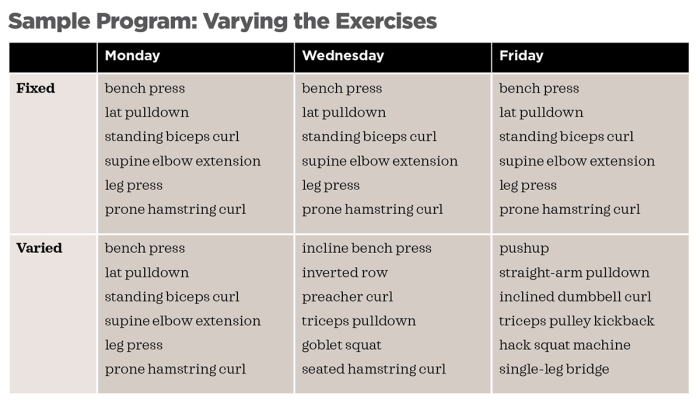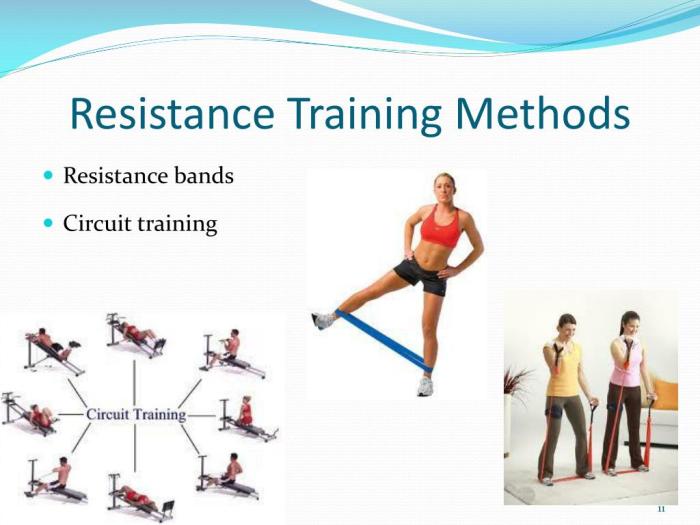Welcome to the world of resistance training methods, where you’ll discover how to harness the power of resistance to transform your body and health. From building muscle and strength to improving endurance and weight management, resistance training offers a versatile and effective approach to fitness.
This comprehensive guide will delve into the different types of resistance training methods, their benefits, and how to choose the right approach for your individual goals. We’ll cover safety and technique, provide sample programs for beginners and advanced lifters, and explore the unique applications of resistance training for special populations, rehabilitation, athletes, women, and men.
Resistance Training Methods

Resistance training methods involve exercises that make use of an opposing force to build strength, power, and muscular endurance. These methods can be categorized into various types based on the equipment used, the movement patterns, and the training goals.
Types of Resistance Training Methods
Resistance training methods can be classified into the following types:
- Bodyweight Training:This method uses only one’s own body weight as resistance, making it accessible and convenient. It includes exercises like push-ups, squats, and lunges.
- Free Weight Training:This method involves using free weights such as dumbbells, barbells, and kettlebells. It allows for a wide range of exercises and greater control over the resistance.
- Machine Training:This method uses weightlifting machines that provide a guided movement path. It offers a safer and more controlled training experience, making it suitable for beginners and those with injuries.
- Resistance Band Training:This method uses elastic bands that provide variable resistance throughout the range of motion. It is portable, versatile, and can be used for various exercises.
Benefits of Resistance Training Methods
Resistance training methods offer numerous benefits, including:
- Increased Muscle Strength and Power:Resistance training helps build and strengthen muscles, improving overall strength and power.
- Improved Body Composition:Resistance training can help reduce body fat and increase lean muscle mass, resulting in a more toned and sculpted physique.
- Enhanced Bone Density:Resistance training can help increase bone density, reducing the risk of osteoporosis and fractures.
- Improved Metabolic Rate:Resistance training can increase the body’s metabolic rate, helping burn calories even at rest.
- Reduced Risk of Chronic Diseases:Resistance training has been linked to a reduced risk of chronic diseases such as heart disease, stroke, and type 2 diabetes.
Types of Resistance Training Methods

Resistance training is a form of exercise that involves the use of an external force to challenge the muscles and promote their growth and strength. There are various types of resistance training methods, each with its own unique characteristics, benefits, and drawbacks.
The following table provides a comparison of the different types of resistance training methods:
| Type | Description | Pros | Cons |
|---|---|---|---|
| Bodyweight Training | Exercises that use only the weight of your own body as resistance | Convenient, inexpensive, and can be done anywhere | May not be challenging enough for advanced individuals |
| Free Weight Training | Exercises that use dumbbells, barbells, or kettlebells as resistance | Allows for a wide range of exercises and flexibility | Requires access to equipment and can be dangerous if not done properly |
| Machine Weight Training | Exercises that use weight machines to provide resistance | Safer and easier to learn than free weight training | Limited range of exercises and can be less effective for building strength |
| Resistance Band Training | Exercises that use resistance bands to provide resistance | Portable, versatile, and can be used for a variety of exercises | May not be as challenging as other methods |
| Isometric Training | Exercises that involve holding a muscle contraction against a fixed object | Can be used to strengthen specific muscles and improve stability | May not be as effective for building strength and muscle mass |
Bodyweight Training
Bodyweight training is a form of resistance training that uses only the weight of your own body as resistance. This type of training is convenient, inexpensive, and can be done anywhere. Bodyweight training exercises include push-ups, pull-ups, squats, and lunges.
Bodyweight training is a great way to build strength, endurance, and flexibility. It can also help to improve balance and coordination. However, bodyweight training may not be challenging enough for advanced individuals.
Free Weight Training
Free weight training is a form of resistance training that uses dumbbells, barbells, or kettlebells as resistance. This type of training allows for a wide range of exercises and flexibility. Free weight training exercises include bench press, squats, deadlifts, and overhead press.
Free weight training is a great way to build strength, muscle mass, and power. It can also help to improve balance and coordination. However, free weight training requires access to equipment and can be dangerous if not done properly.
Machine Weight Training
Machine weight training is a form of resistance training that uses weight machines to provide resistance. This type of training is safer and easier to learn than free weight training. Machine weight training exercises include leg press, chest press, and lat pulldown.
Machine weight training is a great way to build strength and muscle mass. It can also help to improve balance and coordination. However, machine weight training is limited to the range of exercises available on the machine.
Resistance Band Training
Resistance band training is a form of resistance training that uses resistance bands to provide resistance. This type of training is portable, versatile, and can be used for a variety of exercises. Resistance band training exercises include bicep curls, tricep extensions, and squats.
Resistance band training is a great way to build strength and endurance. It can also help to improve flexibility and balance. However, resistance band training may not be as challenging as other methods.
Isometric Training
Isometric training is a form of resistance training that involves holding a muscle contraction against a fixed object. This type of training can be used to strengthen specific muscles and improve stability. Isometric training exercises include planks, wall sits, and calf raises.
Isometric training is a great way to improve strength and stability. It can also help to reduce pain and improve posture. However, isometric training may not be as effective for building strength and muscle mass.
Safety and Technique in Resistance Training Methods

Resistance training methods involve applying force against an external resistance to build muscle strength and endurance. Safety and proper technique are crucial to maximize benefits and minimize risks.
Importance of Safety and Technique, Resistance training methods
Proper form and technique ensure that the exercises are performed correctly, targeting the intended muscle groups while minimizing strain or injury to joints and muscles.
Tips for Proper Form and Technique
- Start with a weight that is challenging but allows you to maintain good form.
- Focus on the movement, engaging the correct muscle groups.
- Keep your back straight and core engaged.
- Control the movement throughout the entire range of motion.
- Avoid swinging or using momentum.
Risks of Improper Form and Technique
- Increased risk of injury to muscles, joints, or tendons.
- Reduced effectiveness of the exercise.
- Compensation patterns that can lead to further imbalances.
Benefits of Proper Form and Technique
- Increased muscle activation and strength gains.
- Improved joint stability and mobility.
- Reduced risk of injury.
- Enhanced overall fitness and performance.
Consequences of Improper Form and Technique
- Muscle imbalances and weakness.
- Joint pain and instability.
- Reduced progress and increased risk of injury.
Examples of Proper and Improper Form
Proper Form:Bench press with a straight back, engaged core, and controlled movement.
Improper Form:Bench press with an arched back, loose core, and swinging motion.
Summary Table: Key Points of Safety and Technique
| Aspect | Proper Form | Improper Form |
|---|---|---|
| Back | Straight | Arched |
| Core | Engaged | Loose |
| Movement | Controlled | Swinging |
| Range of Motion | Full | Limited |
| Weight | Challenging but manageable | Too heavy or too light |
Expert Quote
“Proper form is the foundation of effective and safe resistance training. It ensures that the exercises are performed correctly, maximizing benefits and minimizing risks.”Dr. Michael Smith, Exercise Physiologist
Resources for Further Learning
- National Strength and Conditioning Association: https://www.nsca.com/
- American Council on Exercise: https://www.acefitness.org/
- ExRx.net: https://exrx.net/
Last Recap

Whether you’re a seasoned lifter or just starting your fitness journey, resistance training methods can empower you to reach your fitness aspirations. By embracing the principles Artikeld in this guide, you’ll unlock the transformative potential of resistance training and reap the rewards of a stronger, healthier, and more capable body.
FAQ Guide: Resistance Training Methods
What are the different types of resistance training methods?
There are various types of resistance training methods, including bodyweight exercises, free weights, resistance bands, and machines.
Which resistance training method is best for beginners?
Bodyweight exercises and resistance bands are excellent options for beginners due to their accessibility and ease of use.
How often should I do resistance training?
For optimal results, aim for 2-3 resistance training sessions per week, targeting different muscle groups each session.
Is resistance training safe for people with injuries?
Yes, resistance training can be modified to accommodate injuries. It’s crucial to consult with a healthcare professional or physical therapist for guidance.
Leave a Reply